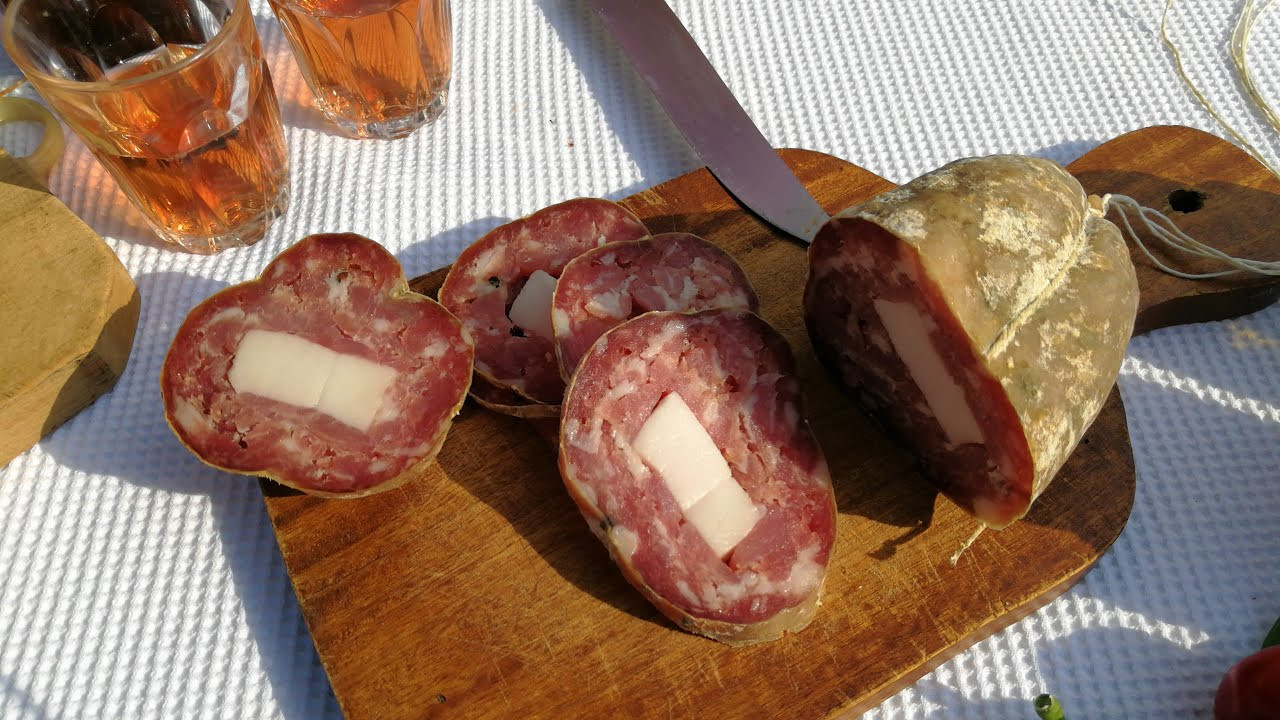Coglioni di Mulo – or Mule's Testicles – is the rather colorful name of an Italian salami made from cured pork, defined by a thoroughly unique taste and aroma. Its name is not a commercial gimmick; its etymology stretches far back in time, much like its history. Read on to learn more about this one-of-a-kind food item. We guarantee it's worth it!
OriginsTo discover the origins of this salami, we need to visit the mountainous landscape of the central Italian region of Abruzzo, which is home to
Campotosto, a small town overlooking a breathtaking lake. This is the ancient birthplace of Coglioni di Mulo, even though its unusual name is a somehow recent invention, being a little less than a 100 years old. Historically, this salami was known as
Mortadella di Campotosto. It was produced in small quantities, usually for family use, as well as for sale in neighboring villages. Starting towards the end of the 19th century, and especially after WW2, Italy experienced a time of great societal change. Roads and highways were built, and mules and horses were replaced with cars and trucks. People travelled more, as did goods: regional products started being sold in larger areas and arrived in the major cities. The salami we’re writing about started being sold far across the mountains of Abruzzo, and as far as Rome! It is here that this specialty took on its current name,
Coglioni di Mulo. This item's unusual shape inspired the Roman folk’s imagination. It is said that the inhabitants of the Eternal City would see these oval-shaped Abruzzan salami hanging in pairs in the local food markets, and they started calling them by the Roman dialect term,
cojoni de mulo, which emphasized the product's visual similarity to a certain animal's body parts.
While it is of Abruzzan origin, a similar product exists in Norcia, near Perugia, in the central Italian region of Umbria. Recently, this item was given the same name. While it is also an excellent product, it cannot beat the original, whose authenticity is so niche that it cannot be mass-produced. Therefore beware, in case you’re in Assisi, Perugia, Orvieto or any other fantastic town of Umbria region, you will find “mule’s testicles” that taste differently than the one we’re writing about in this post.
 Preservation and PromotionThere are many regulations and initiatives in modern-day Italy
Preservation and PromotionThere are many regulations and initiatives in modern-day Italy that serve to protect biodiversity and promote local products, including authentic Mortadella di Campotosto. These take place both on the local level, thanks to the organization of regional producers, as well as on a national one, due to the efforts of the Ministry of Agriculture. In order to make genuine
Coglioni di Mulo, a producer must be verified and undergo strict controls, guaranteeing (s)he creates this item according to precise standards and rules pertaining solely to this product. This is what separates
authentic Coglioni di Mulo from the mass-produced variety that is sold in shops throughout central Italy. While quality, taste and aroma are of utmost importance, so are local sustainability, territory and producer. Genuine Mortadella di Campotosto is the result of artisanal production methods that have been preserved for over 500 years. There are very few who follow these techniques, often only at the family level. In fact, the number of
officially registered producers at the highest and most exclusive level, is only two!
How are they made Mortadella di Campotosto
Mortadella di Campotosto is a cured pork sausage. It is made in the winter using pork raised in Italy's Monti della Laga mountain range. Lean cuts from the shoulder and thighs are finely chopped together with pancetta – a type of Italian bacon made from pork belly.
Seasonings such as wine, salt, pepper and other spices are then added. This preparation is left to rest for at least 24 hours in a wooden bowl, so that the flavors blend together. After this, it is stuffed into a natural casing. One of its unique features is that the meat preparation surrounds a central
stick of lard, measuring approximately 10 cm / 4 inches, which runs the entire length of the salami. Only one of the salami's ends are tied, on the side where the lard was inserted. It is aged for 15 days in front of a fireplace, exposing it to fragrant oak and beech smoke. It is then left to mature naturally, in ideally humid, windy and cold conditions that can only be achieved in cellars filled with altitudinous mountain air. After three months, the product is ready, just in time for Easter!
Mortadella di Campotosto is known for its unique shape: a pair of two oval salami that are tied together with a string and dangled from a pole. It is also unusual when sliced. The casing has irregular contours, while its finely chopped meat is a pleasant, uniform shade of red surrounding a distinctive, large, white square of lard.
Serving Suggestions
If you are lucky enough to get your hands on perfectly made authentic
Coglioni di Mulo while visiting Campotosto and its surrounding areas, you will not want to ruin the experience. The best way to eat this culinary delight is by cutting it into thick slices so that the lard melts in your mouth, blending with the lean meat, creating an amazing play on texture. You can also try this product with a piece of homemade bread. Finally, you will want to drink plenty of pure, clean spring water, which is found in abundance in the area, although the best accompaniment is an intense, full-bodied red wine, such as a Montepulciano d’Abruzzo.


